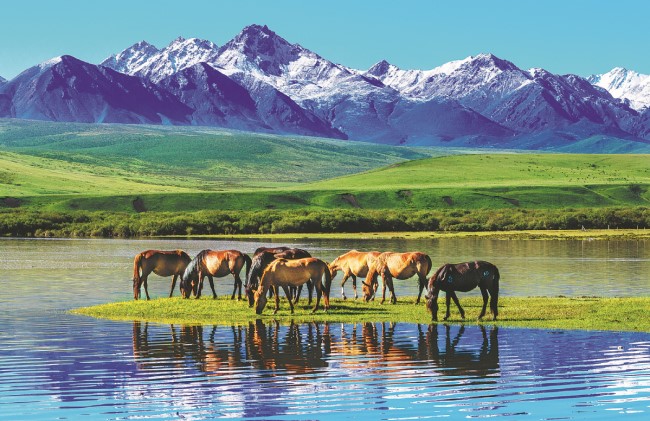Gumption overcomes environmental woes
Editor's note: China has seen tremendous changes nationwide, from economic growth to environmental protection, from social improvement to cultural progress. In this series, China Daily maps the changes and tells the stories of the people who lived through them.
On the map, the contour of Northwest China's Gansu province resembles a ruyi, a scepter or baton that has a long S-shaped handle and a head fashioned like a fist or a cloud.

Horses graze on the pastureland at the foot of the Qilian Mountains in Gansu. [Photo/China Daily]
In the head of that shape, its capital, Lanzhou, is located in the barren landscapes of the Loess Plateau, where long scars formed by water erosion run from the top of the mountains down to the surface. In the south, Gansu sits on the eastern edge of the Qinghai-Tibet Plateau, where China's mother river, the Yellow River, has its first big bend in Maqu county, Gannan Tibetan autonomous prefecture. Hailed as the "kidney of the Yellow River" and the "water tower of the plateau", Maqu sees the upper streams of the Yellow River and the Yangtze River, and their 122 branches, run across it.
The ruyi's long handle reaches far northwest, crossing the Yellow River, along the Qilian Mountains and the 1,000-kilometer Hexi Corridor-the artery connecting China with Central Asia that served as a conduit for Buddhism, trade and military ventures in ancient times-and meeting a part of the Kumtag Desert in Dunhuang, home of the UNESCO Cultural Heritage site Mogao Grottoes.
With deserts, semideserts, gobis, oases, grassland, wetland, mountains, glaciers, loess soil and plateau, Gansu is one of the most geographically diversified provinces in China. However, it is also one of the nation's most environmentally fragile areas. In 2017, more than 43 percent of Gansu's surface area, 195,000 square kilometers, was desertified land, and more than 27 percent was sandified. While severely hobbling the province's economic growth, the fragile environment also posed a serious challenge to people's livelihoods.
With unremitting efforts over the last decade, Gansu, once one of the most poverty-stricken provinces in China, has not only greatly improved its environment, but also has eradicated extreme poverty. "With tremendous efforts, we have won the war against extreme poverty," Yin Hong, Party secretary of Gansu, said at a news conference in May. "The goal to ensure people's daily needs, housing, medical care, education and water safety has been completely realized. We have greatly improved the lives of 5.52 million people from 7,262 villages of 75 counties who suffered from poverty."
Last year, the income of people lifted out of poverty exceeded 10,000 yuan ($1,474) per capita in Gansu for the first time. Their disposable income grew from 2,415 yuan in 2013 to 8,539 yuan in 2020.
-
As AI encounters Dunhuang's art, the ancient caisson ceiling bridges centuries to the present.
View all stories

 Gansu thrives from green development
Gansu thrives from green development  >
>